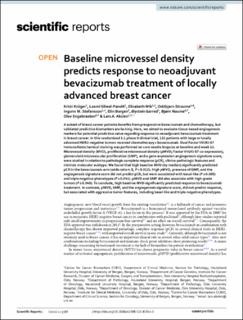Baseline microvessel density predicts response to neoadjuvant bevacizumab treatment of locally advanced breast cancer
| dc.contributor.author | Krüger, Kristi | |
| dc.contributor.author | Silwal-Pandit, Laxmi | |
| dc.contributor.author | Wik, Elisabeth | |
| dc.contributor.author | Straume, Oddbjørn | |
| dc.contributor.author | Stefansson, Ingunn Marie | |
| dc.contributor.author | Borgen, Elin | |
| dc.contributor.author | Garred, Øystein | |
| dc.contributor.author | Naume, Bjørn | |
| dc.contributor.author | Engebråten, Olav | |
| dc.contributor.author | Akslen, Lars Andreas | |
| dc.date.accessioned | 2021-08-11T08:57:04Z | |
| dc.date.available | 2021-08-11T08:57:04Z | |
| dc.date.created | 2021-06-07T12:53:03Z | |
| dc.date.issued | 2021 | |
| dc.identifier.issn | 2045-2322 | |
| dc.identifier.uri | https://hdl.handle.net/11250/2767327 | |
| dc.description.abstract | A subset of breast cancer patients benefits from preoperative bevacizumab and chemotherapy, but validated predictive biomarkers are lacking. Here, we aimed to evaluate tissue-based angiogenesis markers for potential predictive value regarding response to neoadjuvant bevacizumab treatment in breast cancer. In this randomized 1:1 phase II clinical trial, 132 patients with large or locally advanced HER2-negative tumors received chemotherapy ± bevacizumab. Dual Factor VIII/Ki-67 immunohistochemical staining was performed on core needle biopsies at baseline and week 12. Microvessel density (MVD), proliferative microvessel density (pMVD; Factor VIII/Ki-67 co-expression), glomeruloid microvascular proliferation (GMP), and a gene expression angiogenesis signature score, were studied in relation to pathologic complete response (pCR), clinico-pathologic features and intrinsic molecular subtype. We found that high baseline MVD (by median) significantly predicted pCR in the bevacizumab-arm (odds ratio 4.9, P = 0.012). High pMVD, presence of GMP, and the angiogenesis signature score did not predict pCR, but were associated with basal-like (P ≤ 0.009) and triple negative phenotypes (P ≤ 0.041). pMVD and GMP did also associate with high-grade tumors (P ≤ 0.048). To conclude, high baseline MVD significantly predicted response to bevacizumab treatment. In contrast, pMVD, GMP, and the angiogenesis signature score, did not predict response, but associated with aggressive tumor features, including basal-like and triple-negative phenotypes. | en_US |
| dc.language.iso | eng | en_US |
| dc.publisher | Nature Research | en_US |
| dc.rights | Navngivelse 4.0 Internasjonal | * |
| dc.rights.uri | http://creativecommons.org/licenses/by/4.0/deed.no | * |
| dc.title | Baseline microvessel density predicts response to neoadjuvant bevacizumab treatment of locally advanced breast cancer | en_US |
| dc.type | Journal article | en_US |
| dc.type | Peer reviewed | en_US |
| dc.description.version | publishedVersion | en_US |
| dc.rights.holder | Copyright The Author(s) 2021 | en_US |
| dc.source.articlenumber | 3388 | en_US |
| cristin.ispublished | true | |
| cristin.fulltext | original | |
| cristin.qualitycode | 1 | |
| dc.identifier.doi | 10.1038/s41598-021-81914-0 | |
| dc.identifier.cristin | 1914170 | |
| dc.source.journal | Scientific Reports | en_US |
| dc.identifier.citation | Scientific Reports. 2021, 11, 3388. | en_US |
| dc.source.volume | 11 | en_US |
Files in this item
This item appears in the following Collection(s)
-
Department of Clinical Medicine [2044]
-
Registrations from Cristin [9489]

